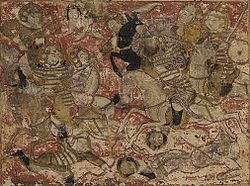ยุทธการที่ศิฟฟีน
ยุทธการที่ศิฟฟีน เป็นสงครามที่สองในฟิตนะฮ์ครั้งแรกหลังจากสงครามอูฐ ระหว่างอะลี เคาะลีฟะฮ์องค์ที่สี่ กับมุอาวิยะฮ์ที่ 1 สู้กับในบริเวณฝั่งแม่น้ำยูเฟรทีสที่ศิฟฟีน (ปัจจุบันอยู่ในเมืองอัรร็อกเกาะฮ์, ประเทศซีเรีย) กองทัพสองฝ่ายตั้งค่ายเป็นเวลามากกว่างสองเดือน และกุรเราะอ์จากกองทัพอะลีได้เริ่มโจมตีในวันที่ 26 กรกฎาคม (8 เศาะฟัร ฮ.ศ. 37) และสิ้นสุดในวันที่ 28 กรกฎาคม (10 เศาะฟัร ฮ.ศ. 37) สงครามจบลงเมื่อทั้งสองฝ่ายหยุดสู้และแก้ปัญหาผ่านอนุญาโตตุลาการ
| ยุทธการที่ศิฟฟีน وقعة صفين | |||||||
|---|---|---|---|---|---|---|---|
| ส่วนหนึ่งของ ฟิตนะฮ์ครั้งแรก | |||||||
 | |||||||
| |||||||
| คู่สงคราม | |||||||
| รัฐเคาะลีฟะฮ์รอชิดีน | บนูอุมัยยะฮ์ | ||||||
| ผู้บังคับบัญชาและผู้นำ | |||||||
| |||||||
| กำลัง | |||||||
| ชาย 80,000 คน[3] | ชาย 120,000 คน[3] | ||||||
| ความสูญเสีย | |||||||
| 25,000[4] | 40,000[4] | ||||||
ที่ตั้ง แก้
สมรภูมินี้อยู่ที่ศิฟฟีน ซากปรักหักผังของมู่บ้านสมัยจักรวรรดิไบแซนไทน์ที่อยู่ห่างจากฝั่งขวาของแม่น้ำยูเฟรทีสไปไม่กี่ร้อยยาร์ด ซึ่งเป็นบริเวณใกล้เคียงกับอัรร็อกเกาะฮ์, ประเทศซีเรียในปัจจุบัน มักถูกระบุเป็นหมู่บ้านตัลอะบูฮุร็อยเราะฮ์, เขตผู้ว่าการร็อกเกาะฮ์ในปัจจุบัน[5]
บรรณานุกรม แก้
- Lecker, M. (1997). "Ṣiffīn". ใน Bosworth, C. E.; van Donzel, E.; Heinrichs, W. P. & Lecomte, G. (บ.ก.). The Encyclopaedia of Islam, New Edition, Volume IX: San–Sze. Leiden: E. J. Brill. pp. 552–556. ISBN 978-90-04-10422-8.
อ้างอิง แก้
- ↑ Battle of Ṣiffīn, Encyclopædia Britannica, retrieved on April 17, 2019. "ʿAlī gathered support in Kūfah, where he had established his centre, and invaded Syria. The two armies met along the Euphrates River at Ṣiffīn (near the Syrian-Iraqi border), where they engaged in an indecisive succession of skirmishes, truces, and battles, culminating in the legendary appearance of Muʿāwiyah's troops with copies of the Qurʾān impaled on their lances—supposedly a sign to let God's word decide the conflict." Archived at the Wayback machine
- ↑ Muʿāwiyah I, Encyclopædia Britannica, retrieved on April 17, 2019. "As a kinsman of the slain caliph ʿUthmān, Muʿāwiyah bore the duty of revenge. Because ʿAlī neglected to apprehend and punish ʿUthmān's murderers, Muʿāwiyah regarded him as an accomplice to the murder and refused to acknowledge his caliphate. Thereupon ʿAlī marched to the Euphrates border of Syria and engaged Muʿāwiyah's troops at the famous Battle of Ṣiffīn (657). Muʿāwiyah's guile turned near defeat into a truce. Resorting to a trick that played upon the religious sensibilities of ʿAlī's forces, he persuaded the enemy to enter into negotiations that ultimately cast doubt on the legitimacy of ʿAlī's caliphate and alienated a sizable number of his supporters." Archived at the Wayback machine
- ↑ 3.0 3.1 Ibn Yaqubi, Ahmad (872). Tarikh Al Yaqubi. Armenia: Ahmad Ibn Yaqubi. p. 188. ISBN 9786136166070.
- ↑ 4.0 4.1 Muir, William (1891). The Caliphate, its Rise and Fall. London: William Muir. p. 261.
- ↑ Lecker, p. 552.